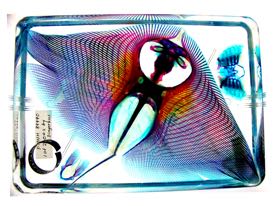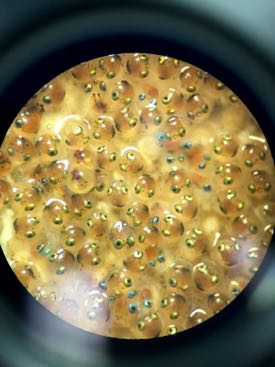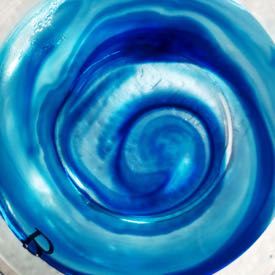VIMS announces winners of 2016 Photo Contest
Winning entries range from finely detailed to abstract
The Virginia Institute of Marine Science has announced the winners of its 17th annual photo contest, an in-house competition held to recognize and honor the most captivating images taken by VIMS faculty, students, and staff during their scientific work in the field and laboratory.
 The first-place winner is PhD student Kristene Parsons, for her photo of a cleared and stained butterfly ray (Gymnura micrura) held in the collections of Chicago’s Field Museum of Natural History. Her study of this specimen (FMNH 89990) and those in other museum collections will contribute to the taxonomic revision and description of a new species of butterfly ray from the Mid-Atlantic Bight. Cleared and stained skeletons are used in fish collections worldwide—including the Nunnally Ichthyology Collection at VIMS—to help researchers more easily distinguish between cartilage (blue), bone (red), and muscle (clear). Scientists use detailed analysis of these tissues to classify organisms into the correct taxonomic category.
The first-place winner is PhD student Kristene Parsons, for her photo of a cleared and stained butterfly ray (Gymnura micrura) held in the collections of Chicago’s Field Museum of Natural History. Her study of this specimen (FMNH 89990) and those in other museum collections will contribute to the taxonomic revision and description of a new species of butterfly ray from the Mid-Atlantic Bight. Cleared and stained skeletons are used in fish collections worldwide—including the Nunnally Ichthyology Collection at VIMS—to help researchers more easily distinguish between cartilage (blue), bone (red), and muscle (clear). Scientists use detailed analysis of these tissues to classify organisms into the correct taxonomic category.
 Taking second place was Darian Kelley, a laboratory specialist at VIMS' Eastern Shore Laboratory in Wachapreague, for her image 'Eye' Can See You—which shows a teeming mass of developing goby eggs taken through a dissecting microscope. She observed the eggs on a ceramic tile retrieved from local waters as part of an experiment by ESL Director Richard Snyder to compare the make-up and diversity of marine communities on oyster reefs and other nearby habitats. Gobies, the largest family of marine fishes with more than 1,500 species, are typically small bottom dwellers that use their fused pelvic fins as a sucking disk to hug the seafloor. The five goby species in Chesapeake Bay and Virginia's coastal waters often associate with oyster reefs.
Taking second place was Darian Kelley, a laboratory specialist at VIMS' Eastern Shore Laboratory in Wachapreague, for her image 'Eye' Can See You—which shows a teeming mass of developing goby eggs taken through a dissecting microscope. She observed the eggs on a ceramic tile retrieved from local waters as part of an experiment by ESL Director Richard Snyder to compare the make-up and diversity of marine communities on oyster reefs and other nearby habitats. Gobies, the largest family of marine fishes with more than 1,500 species, are typically small bottom dwellers that use their fused pelvic fins as a sucking disk to hug the seafloor. The five goby species in Chesapeake Bay and Virginia's coastal waters often associate with oyster reefs.
The third-place winner is PhD student Gail Schwieterman, for her abstract image of a swirling mixture of salt and freshwater. She says she captured the image "as part of the initial training for graduate students involved in the Virginia Scientist and Educators Alliance." VA SEA, offered by professional-development educators at VIMS and in the Chesapeake Bay National Estuarine Research program, provides opportunities for graduate students  affiliated with Virginia Sea Grant universities to learn best practices for communicating their research by developing lesson plans for middle and high school classrooms. Schwieterman says mixing of salt and freshwater—which clearly illustrates their differing densities—is an activity like those that middle school teachers would use in the classroom.
affiliated with Virginia Sea Grant universities to learn best practices for communicating their research by developing lesson plans for middle and high school classrooms. Schwieterman says mixing of salt and freshwater—which clearly illustrates their differing densities—is an activity like those that middle school teachers would use in the classroom.
Honorable mention
The selection committee, headed by VIMS Publications Manager Sue Stein, also awarded five honorable mentions:
- Jenny Dreyer—close-up of a mantis shrimp
- Willy Goldsmith—Atlantic Bluefin Tuna
- Robert Isdell—a twilight image of the Coleman Bridge and Yorktown
- Alynda Miller—a ghost crab camouflaged among shell fragments and beach sand
- Hotta Masaru—an embryo of the Eastern oyster Crassotrea virginica
"Most and best ever"
This year’s contest garnered 145 entries, the most ever submitted. Stein says "this year's entries were overall the best we've ever received, which made it very difficult to choose the winners." She "greatly appreciates the efforts of those who submit their photos," and particularly enjoyed the large number of photos taken using microscopes. Stein notes that VIMS uses photo-content entries to help illustrate its print publications, outreach materials, and website.
VIMS Dean and Director John Wells says he enjoys the photos for their "engaging illustration of the incredible diversity of lab and fieldwork pursued by VIMS scientists in Chesapeake Bay and around the world."
High-resolution versions of the winning images are available on the VIMS Flickr page at http://bit.ly/vimspc2016

